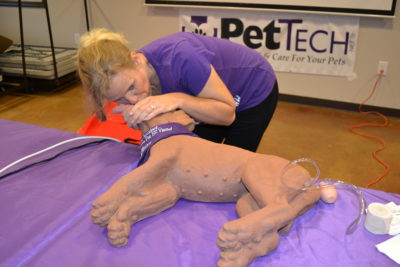Listen to audio version aired on Aug. 4, 2017

Produced and written by Katja Ridderbusch
Summer is a busy time for Anne Blanton — and a time full of adventures for her four-legged clients. Blanton is the owner of Brookhaven Barks, a pet-sitting agency for dogs that also welcomes other animals as well.
Blanton often has to deal with the flip side of summer temptations, in Georgia particularly — snakebites and heat strokes, for example, and all the nicks and cuts that come with exploring the outdoors.
“I want to be fully prepared for any type of emergency,” she says.
That’s why she decided to enroll herself and her employees in a CPR and first aid class, one specifically designed for pets.
The demand for pet CPR and first aid classes has been on the rise for the past several years. The movement is led by a few pioneering companies, such as California-based Pet Tech, which offers rigorous, hands-on classes across the United States.
Pet Tech says that in 2016, it trained over 1,000 people per month. When the company started 20 years ago, only a few dozen attended the classes. Other organizations, such as the American Red Cross, offer pet first aid mobile apps, as well as online courses.
“About half of my students are taking the class because they’ve already lost a pet,” says Nicole Essawy, a certified Pet Tech instructor who also teaches about pet nutrition and lifestyle through her own company DobieMom.com.

Other participants, like Blanton, simply want to be more knowledgeable in dealing with the pets they own or care for.
The class takes place on a muggy Saturday in a Brookhaven community center. There are 10 participants. Most have done a human CPR and first aid class some time ago.
“While we see many similarities, there are also some significant differences between human and pet first aid,” the instructor says.
German-born Essawy, with a cheerful smile and thick blond hair wrapped in a casual bun, covers a range of common pet emergencies: choking and poisoning; bleeding, fractures and shock; bites and stings; and heat and cold injuries.
She hands out stuffed dog and cat dummies and shows how to properly bandage a wound, apply a splint and a tourniquet and stabilize an impaled object with whatever is at hand — be it a gauze roll, a small container or a paper cup.
The most interactive part of the class is a group exercise on how to perform CPR on pets. Choking, heat stroke or an allergic reaction are the main reasons why a pet needs to be resuscitated, Essawy says.
She hunkers over a special CPR rubber dog mannequin and demonstrates chest compressions and rescue breathing. There are different types of compressions for pets, depending on species, size and breed. For cats, chest compressions are performed with one hand only — it’s called the Taco grip. Also, instead of mouth to mouth, in pets, rescue breathing is mouth to nose.
“Most people think that CPR is the most important thing they learn in the class,” Essawy says. “But in fact, chances are very small you will ever need to administer CPR to a pet.”
The odds are at about 2 percent, according to the statistics. Also, the CPR success rate is lower in pets than it is in humans.
Lynne Davis Cobb was in the 2 percent bracket.
The owner of Lynne’s Mobile Pet Salon, a mobile grooming business in Fayette County, took a pet CPR and first aid class last year and only weeks later had to jump into action.
She was grooming an elderly, overweight miniature schnauzer named Lexi when the dog suddenly collapsed.
“She wasn’t breathing, so I started administering CPR right away, did chest compressions and rescue breathing like I was taught during the class,” Davis Cobb says.
The dog survived and is still alive and well today.
“It felt very empowering,” she recalls, “because I knew exactly what to do instead of standing there helplessly and watch the dog die on my table.”
Veterinarians sometimes have mixed feelings about the growing pet first aid courses.
“The benefit of hands-on classes, in particular, is that you get the experience of what you can handle as an owner,” says Dr. Jennifer Pittman of Blue Pearl Veterinarian Partners, a large animal emergency clinic in Sandy Springs.
However, the first aid measures should never delay a necessary trip to the animal clinic.
“Those procedures are meant to stabilize the pet and get it to the veterinarian as quickly as possible,” she says. “They are not supposed to replace a vet.”
While she cautions pet owners not to overestimate their newly acquired first aid skills, Pittman points out that the classes can help pet owners better recognize emergencies. For example, panting, rapid heartbeat and excessive salivation can be signs of poisoning.
A frequent mistake untrained pet owners often make is to induce vomiting if the pet has ingested a toxic substance.
“Vomiting is not a benign process,” Pittman explains. Certain substances may be very acidic “and can cause further damage coming up than if they were left down.”
First aid instructor Essawy urges pet owners to save the number of the Pet Poison Helpline on their phones.
Also, there’s some homework to do.
“Go through your house and yard and look for potentially dangerous substances that the pet could access,” Essawy says at the end of her class. For example, a lot of pesticides or car maintenance fluids, such as motor oil or antifreeze, have a sweet taste and, therefore, attract pets to lick them.
“My biggest advice to pet owners is don’t wait until the emergency happens,” Essawy says. Taking the time to learn how to avoid an emergency, and respond appropriately if it does happen, “is one of the biggest gifts we can give our pets.”
And a good investment for pet care professionals, too.
Blanton, the owner of Brookhaven Barks, is glad she took the class and brought her employees along.
“It gives me a lot of comfort knowing our business can provide an additional layer of safety for our pet clients,” she says.

Good info. Lucky me I reach on your website by accident, I bookmarked it.
Wow! This can be one particular of the most useful blogs We have ever arrive across on this subject. Actually Magnificent. I am also a specialist in this topic therefore I can understand your effort.